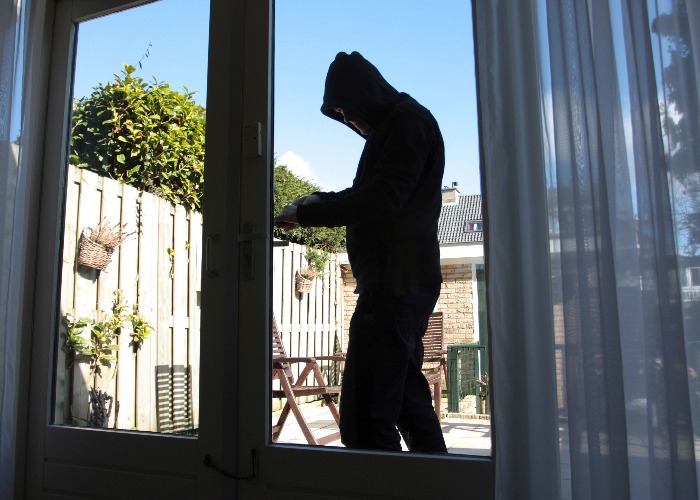Burglary hotspots: Cleveland, South Yorkshire and West Midlands worst affected

Do you live in one of the worst-hit regions for burglary in England and Wales? We reveal the areas where your home is most (and least) likely to be targeted.
Burglary rates have fallen by a massive 70% since 2003, according to the latest figures from the Office for National Statistics (ONS).
During 2023, police received 271,499 reports of domestic burglary, which was down from 890,099 in March 2003 when the ONS records began.
Reassuringly, the figures for 2023 also recorded a 1% fall from the previous year.
While those percentages are encouraging, they don’t change the fact that huge numbers of people still fall victim to this incredibly distressing crime.
What’s more, burglary is more prevalent in some areas than others.
Make sure your valuables are insured: compare home insurance policies
Where am I most likely to be burgled?
New analysis from price comparison service Go Compare has revealed the areas in England and Wales with the highest number of break-ins last year.
The data is based on figures obtained from the Home Office and looks at the number of complaints received by different police forces.
The researchers then calculated the ratio of break-ins per 1,000 households.
In essence, this figure reveals the likelihood of a typical household in a particular region being burgled during 2023.
With the dubious honour of coming first in the list, Cleveland in the North East has a burglary ratio of 1:61, which means that one in every 61 households was broken into during this period.
Next up were South Yorkshire and the West Midlands, with ratios of 1:66 and 1:75 respectively.
The 10 worst-hit regions
|
Ranking |
Police force area |
Burglary ratio |
|
1 |
Cleveland |
1:61 |
|
2 |
South Yorkshire |
1:66 |
|
3 |
West Midlands |
1:75 |
|
4 |
Greater Manchester |
1:88 |
|
5 |
West Yorkshire |
1:89 |
|
6 |
Metropolitan Police (Greater London) |
1:90 |
|
7 |
Humberside |
1:96 |
|
8 |
Hampshire |
1:117 |
|
9 |
Leicestershire |
1:126 |
|
10 |
Durham |
1:127 |
The safest places to live
As well as looking at the riskiest areas, the researchers also identified the regions in England and Wales with the lowest incidence of this type of crime.
With a burglary ratio of 1:395, Devon and Cornwall experience the lowest levels of home break-ins.
Norfolk and Suffolk were the second and third least risky areas, with ratios of 1:335 and 1:297.
The 10 least affected areas
|
Ranking |
Police force area |
Burglary ratio |
|
1 |
Devon and Cornwall |
1:395 |
|
2 |
Norfolk |
1:335 |
|
3 |
Suffolk |
1:297 |
|
4 |
Wiltshire |
1:280 |
|
5 |
Cumbria |
1:273 |
|
6 |
Dyfed-Powys |
1:267 |
|
7 |
North Yorkshire |
1:267 |
|
8 |
South Wales |
1:250 |
|
9 |
North Wales |
1:244 |
|
10 |
Sussex |
1:240 |
Interestingly, Devon and Cornwall also recorded the lowest rates of car vandalism in another recent piece of research.
Will the burglar be caught?
Frustratingly for victims, research from The Telegraph earlier this year revealed that the number of burglars being jailed has more than halved in the past decade.
Although it might be tempting to believe this is due to the decline in actual burglaries, there is more to the story as the proportion of burglars being jailed is also falling.
During 2023, just 1.9 burglars were convicted for every 100 break-ins, which is down from 2.3 in 2013.
However, the figures do reveal that those who appear before a judge charged with burglary are more likely to face prison than a decade ago.
According to The Telegraph’s data, the proportion of burglars receiving jail terms has risen to 58% from 50% in 2013 although this figure stood at an even higher 64% in 2020.
Protecting your home
One of the most effective ways to reduce your risk of a break-in is to make your home less attractive to burglars.
The Metropolitan Police has outlined a host of tips on its website, from boosting the standard of the locks on your front door to removing possible hiding places for burglars in your garden.
Technology can also be a valuable ally, whether through the installation of a burglar alarm or even something like the Ring doorbell, which lets you see who is at your door even if you are away from the property.
But if burglars do find their way into your home, you want to ensure that you have adequate home insurance in place to cover replacing any items that are taken or damaged.
Go through each room of your house and work out how much it would cost you to replace everything in there.
You don’t want to underinsure your home and leave yourself out of pocket should the worst happen.
Check out our guide on how to get the right home insurance cover, without overpaying.
Get a home insurance quote now with Confused.com
*This article contains affiliate links, which means we may receive a commission on any sales of products or services we write about. This article was written completely independently.
Most Recent
Comments
Be the first to comment
Do you want to comment on this article? You need to be signed in for this feature









